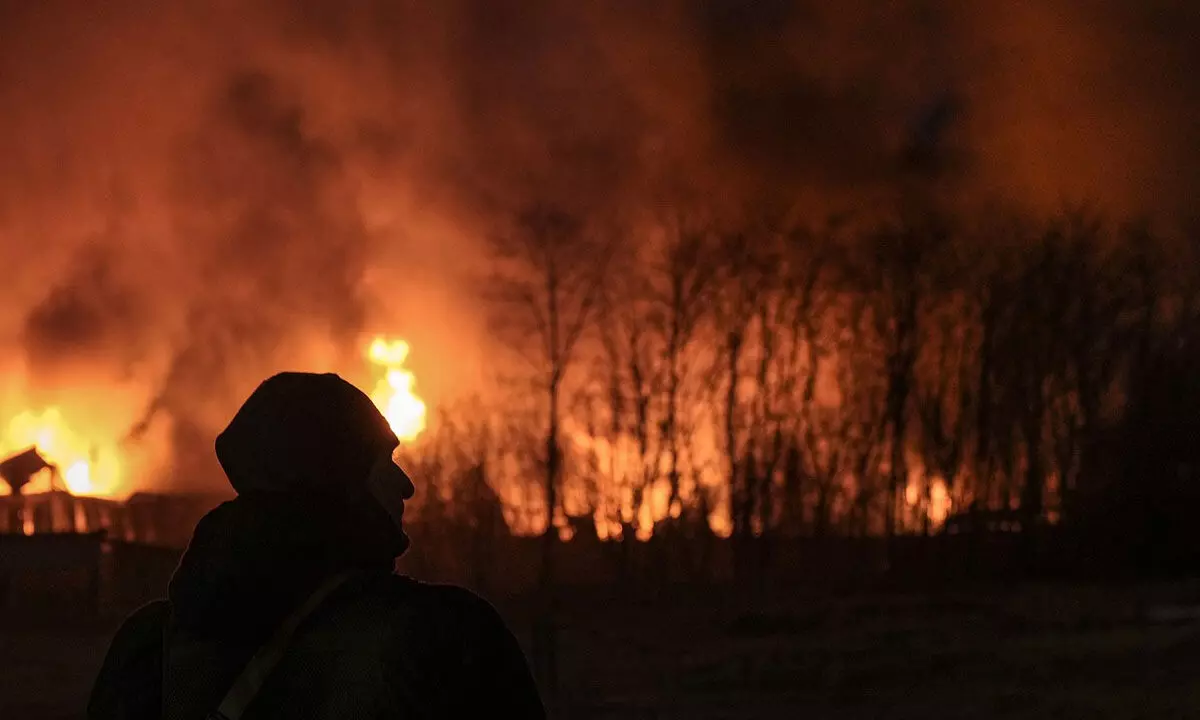How Russia-Ukraine war is harming environment
Russian missiles, targeting industrial facilities, have hit major fuel facilities spreading toxic pollutants, ash and slag in populated areas
image for illustrative purpose

The environmental impact of wars begins long before they do. Building and sustaining military forces consumes vast quantities of resources. These might be common metals or rare earth elements, water or hydrocarbons. Maintaining military readiness means training, and training consumes resources. Military vehicles, aircraft, vessels, buildings and infrastructure all require energy, and more often than not that energy is oil, and energy efficiency is low. The CO2 emissions of the largest militaries are greater than many of the world's countries combined.
Militaries also need large areas of land and sea, whether for bases and facilities, or for testing and training. Military lands are believed to cover between 1-6 per cent of the global land surface. In many cases these are ecologically important areas. While excluding public development from these areas can benefit biodiversity, the question of whether they could be better managed as civil protected areas is rarely discussed. Military training creates emissions, disruption to landscapes and terrestrial and marine habitats, and creates chemical and noise pollution from the use of weapons, aircraft and vehicles.
Sustaining and renewing military equipment and material means ongoing disposal costs, with implications for the environment. It is not just the most hazardous nuclear and chemical weapons that create environmental problems throughout their lifecycle. The same is also true for conventional weapons, particularly where they are disposed of through open burning or detonation. Historically, vast quantities of surplus munitions were also dumped at sea.
Severe pollution incidents can be caused when industrial, oil or energy facilities are deliberately attacked, inadvertently damaged or disrupted. In some cases, deliberate attacks on oil or industrial facilities are used as a weapon of war, to pollute large areas and spread terror. Other scorched earth techniques include the destruction of agricultural infrastructure like canals, wells and pumps and the burning of crops. Tactics like these threaten food security and livelihoods, increasing the vulnerability of rural communities. Whether unintended or deliberate, these large-scale pollution incidents can lead to transboundary impacts from air pollution or through the contamination of rivers, aquifers or the sea. In some instances, these even have the potential to affect weather or the global climate.
Weapons and military materiel used during conflicts also leave environmental legacies. Land mines, cluster munitions and other explosive remnants of war can restrict access to agricultural land and pollute soils and water sources with metals and toxic energetic materials. In major conflicts, large volumes of military scrap may be produced or abandoned, this can contain a range of polluting materials, contaminating soils and groundwater, whilst exposing those who work on it to acute and chronic health risks. Wrecked or damaged ships, submarines and offshore oil infrastructure can cause marine pollution.
Russia's invasion of Ukraine has abruptly transformed the world. Millions have already fled. A new Iron Curtain is grinding into place. An economic war deepens, as the military conflict escalates and civilian casualties rise.
Now, just as Ukraine's environmental movement has matured, with many organizations approximating the influence of those in the West, the unthinkable happened. First an invasion, and then Russian troops stormed the nuclear power plant in the city of Zaporizhzhia and took over the Chernobyl facility, including 22,000 spent reactor fuel assemblies and significant plutonium-239. The results could have been catastrophic and may still be.
As the invasion continues, environmental crimes grow with damages that are extraordinary and purposeful. Russian missiles, targeting industrial facilities, have hit major fuel facilities spreading toxic pollutants, ash and slag in populated areas. The Russians targeted the Kyiv Reservoir and hydropower plant which would have flooded parts of Kyiv had it not been shot down.
Other targets include power supplies for farms, creating biohazards for towns and warehouses containing hazardous materials. Intentional bombing of water supplies, sewage systems and other facilities have devastated local populations. Russian troops attacked major seaports sinking ships and fuel storage facilities, creating widespread contamination. Over a dozen globally important "Ramsar" wetlands, forests, protected areas, homes to endangered and threatened species have suffered grave impacts. Forest fires are now closing in on Chernobyl, once again raising fears. Close to two decades of progress has been wiped out in a few weeks.
United Nations member states attending the UN Environment Assembly's opening session have raised concerns over the environmental impact of the Russia-Ukraine crisis. Russia says they are hypocrites. The meeting coincides with the release of the sixth report of the International Panel on Climate Change. It details the grim effects of the climate crisis on humanity, biodiversity and marine life. While environmental concerns over the conflict cast a shadow over the world's highest-level decision-making body on the environment, urgent concerns were raised over the triple threat of the climate crisis, loss of biodiversity and pollution.

